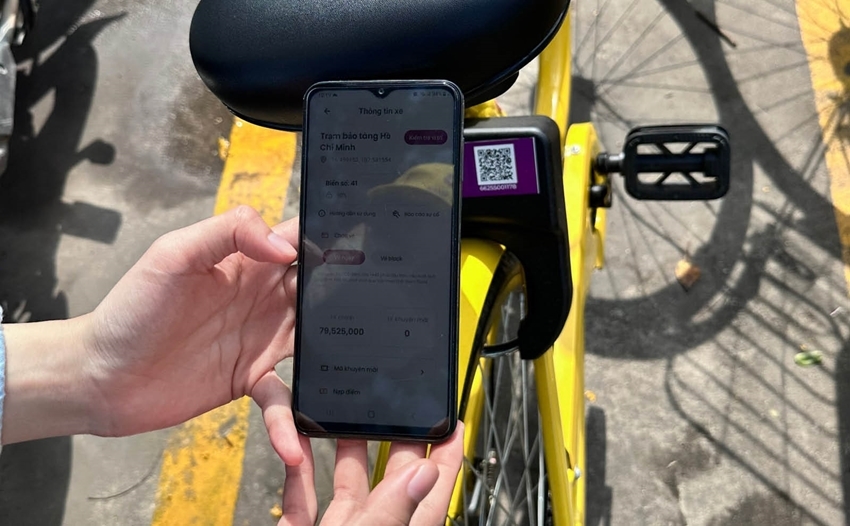The first bicycle city in the country
Twenty years ago, traffic in Hue and across the country was, of course, not what it is now. At that time, we simply wished and thought that by changing the mindset and traffic culture, instead of riding motorbikes, each family should buy a few bicycles to get around. And just like that, Hue would suddenly become the city of 1 million bicycles.
In reality, things are not that simple. With modern traffic, if people want to ride bicycles, the government and the transportation sector must first prepare the necessary infrastructure. In its journey to build a "green city" and "green transportation," Hue can be said to be the first city in the country to set ambitious plans and goals for this.
First, Hue has dedicated a portion of the sidewalks on many city streets for cyclists. This is a solution that many major cities around the world have successfully implemented, encouraging people to cycle while creating a green and environmentally friendly city.
Next, Hue aims to become the first and most distinctive bicycle city in the country by designing various types of bicycle lanes, such as dedicated bicycle lanes, shared bicycle lanes, scenic bicycle paths, bicycle and pedestrian priority lanes, and bicycle highways. They will also separate and create priority lanes for bicycles on main roads, implement various traffic safety improvement measures, install priority traffic lights, enhance the visibility of priority bicycle lanes, and arrange bicycle parking lots and racks.

Tourists scan QR codes through the HueSmartBike app to use bicycles. Photo: Bao Phuoc
Notably, Hue is finalizing the "Comprehensive Infrastructure System Planning Project and Implementation Plan for Bicycle Routes in Hue City and Surrounding Areas." The goal is to make Hue the first and most distinctive bicycle city in the country as soon as possible. While waiting for the approval of this project, the Thua Thien Hue Provincial People's Committee has allowed research and pilot bans on cars and motorbikes on certain streets to reserve them for bicycles on Sundays.
Promoting bicycle use in Hue will certainly bring many practical benefits. First of all, bicycles are non-polluting vehicles, helping to reduce air and noise pollution, and contributing to the fight against climate change. For a city with a rich cultural heritage like Hue, using bicycles also helps preserve the landscape, creating a greener and cleaner living environment. This not only helps protect the environment and improve the quality of life but also creates a special impression of Hue in the eyes of domestic and international visitors.
Vision and challenges
Although Hue's green vision, particularly in the field of transportation, is very clear, its implementation will certainly face many challenges. First, since it is just starting now, the current transportation infrastructure in Hue is not very bicycle-friendly. Building dedicated bicycle lanes requires significant investment and may encounter resistance from some people due to the narrowing of lanes for cars and motorbikes. Additionally, changing the culture and habit of riding motorbikes and cars to bicycles is not something that can be done overnight.
It is clear that Hue can learn from international experiences from cities in many countries that have successfully promoted bicycle use over the past decades. Each city, with its own cultural and transportation characteristics, will provide Hue with specific lessons.
For example, Amsterdam (the Netherlands) will offer Hue experience in investing in bicycle lanes and supporting infrastructure, as well as encouraging bicycle use through financial support and incentive policies.
Copenhagen (Denmark) will offer experience in integrating bicycles into urban planning from the beginning, as well as developing bike-sharing systems to encourage uses and ensure traffic safety for cyclists.
Tokyo (Japan) suggests investing in smart and convenient bicycle parking facilities, providing support policies and incentives for bicycle users, and integrating bicycle systems with other public transportation means.
Successful models from cities around the world show that building a bicycle-friendly city requires investment in infrastructure, supportive policies, and the development of a bicycle culture. Hue can learn and apply these lessons to create a green, clean, and sustainable transportation environment, in line with its vision to become the first and most distinctive bicycle city in Vietnam.
In short, turning Hue into the first and most distinctive bicycle city in Vietnam is an ambitious but entirely achievable goal. However, achieving this goal will require determination, close coordination, and continuous effort from all units. With a green vision and determination, Hue can indeed become a symbol of a friendly, green, clean, and sustainable city, serving as a model for sustainable urban development for the entire country.